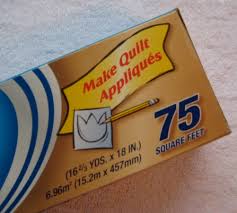T-Shirt Quilts of Texas
The scrapbook you can sleep under.
Great Uses For Freezer Paper
April 02, 2017
Freezer Paper, A Quilters Friend!
 Freezer paper is one of those secret tools that quilters and crafters use that is found at your local grocery store, right next to the aluminum foil storage bags. One side is a matte finished paper, and the other side has a waxy finish. I like Reynolds brand best. I have tried other brands, and they don't seem to adhere as nicely as the Reynolds.
Freezer paper is one of those secret tools that quilters and crafters use that is found at your local grocery store, right next to the aluminum foil storage bags. One side is a matte finished paper, and the other side has a waxy finish. I like Reynolds brand best. I have tried other brands, and they don't seem to adhere as nicely as the Reynolds.
Note: If you happen across a really old box of freezer paper, it might have a 'wax' coating instead of the 'plastic' coating of today's freezer paper. Snag that box, because the 'old stuff' adheres really well. Save the new stuff for wrapping your frozen goods (yeah, right!).
![]()
- Freezer paper is great for Applique. Draw image on matte side, iron to wrong side of fabric. Either draw a line to outline, or fold raw edges over the paper. Stitch in place. Note: this method requires that you slit the backside of the base fabric to get the paper out!
- Free-motion quilting using freezer paper templates. Cut out the shape you want, such as a flower or star, quilt around the template. Move, iron, repeat.
- Use as stencil material. Either cut out a shape or word. Iron on. Paint over the stencil. If painting a t-shirt or other clothing, insert cardboard to keep painting from going through to the backside.
- Use freezer paper as a photo transfer. Print on the waxy side, iron to fabric. (watch out if using words, image will be a mirror-image).
- English Paper Piecing - layer and iron a couple of sheets of freezer paper to make a more sturdy paper. Cut out your paper pieces with a rotary cutter. Fold seam allowances over and baste. After sewing hexies or other shapes together, remove paper and use again!
- Iron the freezer paper to the wrong side of the appliqué fabric. Fold the seam allowances over the edges and press. This will give you a crisp edge to appliqué. Remove the paper before beginning your applique..
- Use freezer paper to help you cut shapes out of fabric! Draw a design on the dull side of the freezer paper and cut it out. Iron the paper (shiny side DOWN) onto a piece of fabric, then cut around the design. You can reuse the same shape over and over – just peel it off and iron again!
- Use it as an embroidery template. Using the same process as the last step, draw a design onto the paper and iron it onto a piece of fabric. Pop the fabric into your embroidery hoop and stitch right over the design; when you’re finished, you can peel and tear away the paper but the stitches will remain.
- Use freezer paper as your foundation for English Paper Piecing. Cut out several shapes from freezer paper as your template for hand stitching, or cut out and iron the shapes onto the paper to create your templates.
- This standard household item can be cut into 8 1/2″ x 11″, fused the shiny side of freezer paper to the the wrong side of fabric and cut fabric to size. The freezer paper will provide enough stabilization to allow the fabric to run through the printer. WOW, it will help you print on fabric. Allow the ink to dry and peel away the paper. Set ink with a hot iron.
- Make those brown tissue paper patterns last longer. Just iron the freezer paper (no steam) to the WRONG side of the tissue. Just flip the paper over, and you are ready to do your cutting.
- For most applications, just tear off a sheet and draw (or print) on the matte side. Cut it out and iron it glossy side down onto your fabric. Should last through several uses. If you are using steam, note that freezer paper can shrink!
An Experienced Quilters Tips:
Only use ink-jet printers, not laser jet printers. The heat can distort your paper.
Iron several layers of freezer paper together to make a thicker paper (more like cardboard stock)
For making templates that you want to make several of the same thing (like applique flower petals), layer several sheets of the paper. Then staple the layers together (or 'lightly' touch with tip of iron to stick) to hold layers together while cutting out.
If you staple inside the image, those will stay in a nice stack while waiting to be used.